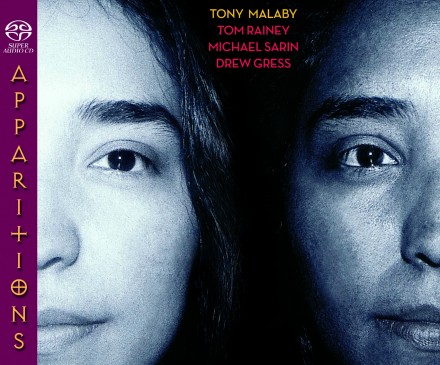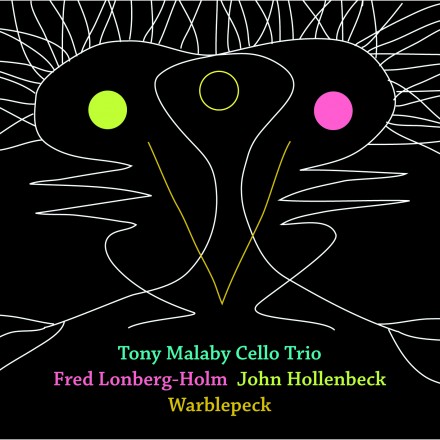Tony Malaby
Apparitions
SGL SA1545-2“[Malaby’s] music calls for an intense rhythm bed and both Tom Rainey and Michael Sarin, brothers of the pulse, interweave to set up that organic fabric…Malaby’s compositions throb with drama. They display a constant urgency, which does not merely mean that the conversation is always heated — it can also be seen when the mood is tranquil, a trait that gives ‘Tula’ its glow before the strain becomes daubed in darker, bolder hue.
— Jerry D’Souza, AllAboutJazz.com
New York saxophonist Tony Malaby’s Mexican-American background and experience playing both inside and outside bring a subtly different flavor to his second record as leader. Apparitions is even more open and exploratory than his debut, Sabino (which made the NY Times’ and Philadelphia City Paper’s top ten jazz lists for 2000). The process began a couple of years ago when he performed several times with two drummers and loved it: “It’s just the most comfortable couch, or like taking a warm bath, just being surrounded by that sound and falling into it.” He soon knew who the band was going be; having played together a lot in various other combinations, they already had a shared vocabulary to build on. They worked with Tony’s structural concepts more than with written-out compositions: “I decided to try to create platforms for my favorite ‘zones’ that we’d developed or would hit on. So for example, a multi-layered zone where the four of us are each playing in our own pulse or dimension in time, or a very transparent zone where it’s cymbals/mallets/brushes and I’m playing flute-like and Drew’s playing arco. And the question is: how am I going to get this into a composition, how am I going to structure it?”
Throughout Apparitions, freedom and form are dual aspects of the music’s evolution. Cutting-edge jazz typically blurs the distinction between composition and improvisation, but seldom are the results so intuitive yet coherent — sinuous group elaborations of uncanny dexterity, the often dense textures retaining a striking clarity. The whole record feels like one extended suite exploring forms and moods on some knife-edge between passion and abstraction. “A big part of the aesthetic is that the composition is hidden, and the improv is equally hidden… Tom, Mike and Drew are masters at creating this effect, because they can absorb the material very quickly and are then able to abstract it and deconstruct it, they create another layer over the written material, even as they perform it… On ‘Talpa’ and ‘Jersey Merge’ there’s a structure that we’re blowing off of, chord changes — ‘Jersey Merge’ is based on the harmonic structure of ‘Bye Bye Blackbird’ — and I knew that I’d get a different type of music from the rest of the record if I incorporated a couple of tunes with form and structure. The way they mask that there is a form there is brilliant, it creates a seamlessness that never constricts me as an improviser.”
Timbral innovation is another area of investigation, “trying to create the illusion that I’m not playing saxophone, that I’m playing marimba or other percussion-like instruments… trying to make the ensemble sound bigger than it really is.” Evoking cultural and natural space is also an important consideration: “I use a lot of imagery or visualization, and at the time of making Apparitions I was dealing a lot with my heritage, so a lot of imagery of adobe, weavings, chilis, cilantro, spices, the ancient pyramids of Mexico… these were on my mind. And there’s a primitiveness in the music — ‘Tula’ at times sounds like I’m blowing into a conch shell… Something I’ve always carried with me from the southwest, moving to New York, is a sense of space. It’s very easy for me to create density and energy but I’m working on spacing that out, pacing myself, and thinking of ‘arcs’ differently, I don’t want things to always start soft, crescendo to a peak, and come down at the end.”
Originally from Tuscon, Tony Malaby has been permanently based in New York since 1995 and has been a member of many notable jazz groups including Paul Motian’s Electric Bebop Band, Marty Ehrlich’s Traveler’s Tales, the Mark Dresser Quartet, Fred Hersch’s quintet and Walt Whitman project, Tim Berne’s Quicksand, Mark Helias’ Open Loose, and bands led by Bobby Previte, Tom Varner, Michael Formanek, and Kenny Wheeler. For more information: www.tonymalaby.net, www.drewgress.com, www.michaelsarin.com.
“Some say John Coltrane was mad with divine love. And they’re right. The voice of the spirit flowed through everything he did, more and more so toward the end. He was indeed doomed to a life of eternal love. Along Coltrane’s course to the great beyond, he saw something special in the sound of two drummers, which was a pretty natural stretch given the way he had continually picked up the sounds of Africa. It’s too bad Rashied Ali and Elvin Jones didn’t share more empathy…Tony Malaby is also crazy with divine love. But he’s figured out how to get two drummers to go along with it…Keeping track of the way these players add and multiply each other is half the fun of the record, really. The other half is Malaby himself, who has such a naked, open voice that you can’t help but believe what he says…No holding back, nothing short of pure honesty in every note. They aren’t necessarily loud, tweaked timbrally, or scattered apart like a flock of doves. All of the above, but Malaby also has the virtue of simultaneously keeping a foot on the ground at all times. That connectedness and organic essence is what informs every crazy note he plays, because Tony Malaby understands very well the weakness of human character. He cries out and — provided you’re listening — you’ll probably learn a little about who you are. When he whispers, you better turn your head…It doesn’t matter if any given piece is pensive or cathartic — and there’s a whole lot of the former — you can feel that light glowing within.” — Nils Jacobson, AllAboutJazz.com
“This New York City based crew, led by the excellent saxophonist, embarks upon a rip-roaring modern jazz program. Nevertheless, it’s the dual drumming attack that provides the mark of authenticity to this soul-stirring set. Rainey and Sarin perform masterfully here! At times, the drumming is akin to a domino effect as they extend rhythms without losing the flow. Malaby leads the charge with his meaty tenor and soprano sax lines. His adroit expressionism and forcefully shaped lyricism provides the axis for the drummers’ zestfully articulated polyrhythms.” — Glenn Astarita, AllAboutJazz.com
**** “These striking new discs…are snapshots of the energy, invention and central operating principles of the finest jazz being played today…a kind of halfway house between the progressive mainstream and the avant-garde…To some, this two-drummer quartet might be geared to pure, visceral playing. But that’s only part of it. Structural matters count, yet you tend to remember the huge servings of saxophone. They’re exhilarating portions indeed, but they can also be exhausting.” — Greg Buium, Downbeat
“Malaby is an excellent, progressively inclined saxophonist, possessed of an expressive tone, formidable technique and fertile imagination…The percussion-heavy environment suits Malaby to a T, due in no small part to the two drummers’ ability to draw complementary timbres and textures from their kits. Malaby himself is no slouch in terms of tone color. His skill at manipulating the saxophones’ timbre enhances his considerable skill at constructing lovely improvised melodies…Sarin and Rainey work hand-in-glove, and Gress is melodically and percussively inventive. Indeed, the band at times seems like a percussion quartet, so concerned are they with rhythmic interaction. This is no bebop album. It’s avant-gardish, but not impenetrable, making it easy to recommend to the serious listener, regardless of his or her stylistic inclincation.” — Chris Kelsey, Jazz Times
*** “His robust tenor fits in well with the adventurous New York City crowd that held court at the Knitting Factory back in the ’90s, while his tone, phrasing, and innate melodicism — not to mention that soulful upper-register wail poised just at the brink of a multiphonic explosion — might even draw comparisons to Coltrane himself. On Apparitions he’s powerful enough to hold his own with a powerhouse rhythm section…Listeners familiar with the N.Y.C. jazz community in which these musicians are leading lights might be drawn to this recording on the basis of the drummers alone; matchups like Rainey and Sarin don’t happen all that often…For Apparitions Malaby has penned original compositions with plenty of space for exploration of mood and texture, tilting a bit further toward free improvisation than his work with bassist Mark Helias’ Open Loose trio, which also features Rainey on drums…Malaby also shows he’s got what it takes on soprano, drawing additional favorable nods from the Coltrane crowd.” — Dave Lynch, All Music Guide
“Malaby guides your ear with groove-based rhythms and blues-drenched tunes, but his textures and dynamics are as unpredictable as his forms. A tune seems to grow in increments as the form is repeated, suggesting either explicit writing or rigorous rehearsal. There are regular meters, but bassist Gress rarely plays straight fours…It’s difficult to tell how much is written and how much improvised. Either way, the listener wins, the familiar and the strange constantly dovetailing. And Malaby’s saxophone sound is big and brawny, in the Lovano manner, with technique to spare.” — Jon Garelick, Boston Phoenix
“Malaby’s reputation has been growing steadily since he moved from Tucson, Arizona to New York City in 1995. Playing with jazzmen on the edge, he’s been successfully blurring the lines between improvisation and composition, and playing a hell of a lot of saxophone in the process…As expected, the two-drummer quartet packs a serious wallop – even more so since the excellent Super Audio production captures the two players with amazing separation and clarity. Malaby’s playing is exceptional and with a sense of grace that just comes naturally. He never lacks passion, but he remains measured in his playing on both tenor and soprano sax throughout. This is a great effort from someone we’ll be hearing a lot more from.” — Tad Hendrickson, CMJ New Music Report
***1/2 “[Malaby’s] already appeared on over 30 recordings as a sideman, with his fluid, harmonically uninhibited, rhythmically loose and lively style a noteworthy addition to bands led by Paul Motian, Marty Ehrlich and Tim Berne, among others…The key word here is rhythm — or, more precisely, rhythms: typically, drummers Michael Sarin and Tom Rainey work in and out of synch, flicking syncopated taps and cymbal splashes into the open spaces between the beats, as big-toned bassist Drew Gress maintains the pulse and Malaby weaves lyrical lines over, around, and through the mix…By sharing careful attention to dynamics and adjustable tempos, the overlapping accents fit together like a kinetic collage…It’s the engaging details along the way, and not the ultimate destination, that make the journey a pleasure.” — Art Lange, epulse!

